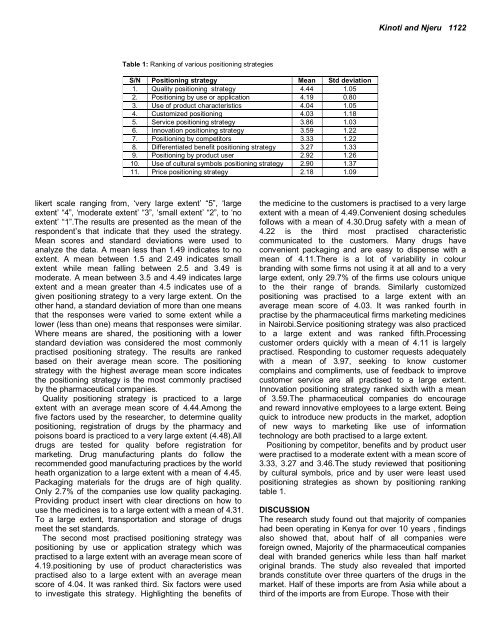Full Article (PDF) - Prime Journals
Full Article (PDF) - Prime Journals
Full Article (PDF) - Prime Journals
You also want an ePaper? Increase the reach of your titles
YUMPU automatically turns print PDFs into web optimized ePapers that Google loves.
Kinoti and Njeru 1122<br />
Table 1: Ranking of various positioning strategies<br />
S/N Positioning strategy Mean Std deviation<br />
1. Quality positioning strategy 4.44 1.05<br />
2. Positioning by use or application 4.19 0.80<br />
3. Use of product characteristics 4.04 1.05<br />
4. Customized positioning 4.03 1.18<br />
5. Service positioning strategy 3.86 1.03<br />
6. Innovation positioning strategy 3.59 1.22<br />
7. Positioning by competitors 3.33 1.22<br />
8. Differentiated benefit positioning strategy 3.27 1.33<br />
9. Positioning by product user 2.92 1.26<br />
10. Use of cultural symbols positioning strategy 2.90 1.37<br />
11. Price positioning strategy 2.18 1.09<br />
likert scale ranging from, „very large extent‟ “5”, „large<br />
extent‟ “4”, „moderate extent‟ “3”, „small extent‟ “2”, to „no<br />
extent‟ “1”.The results are presented as the mean of the<br />
respondent‟s that indicate that they used the strategy.<br />
Mean scores and standard deviations were used to<br />
analyze the data. A mean less than 1.49 indicates to no<br />
extent. A mean between 1.5 and 2.49 indicates small<br />
extent while mean falling between 2.5 and 3.49 is<br />
moderate. A mean between 3.5 and 4.49 indicates large<br />
extent and a mean greater than 4.5 indicates use of a<br />
given positioning strategy to a very large extent. On the<br />
other hand, a standard deviation of more than one means<br />
that the responses were varied to some extent while a<br />
lower (less than one) means that responses were similar.<br />
Where means are shared, the positioning with a lower<br />
standard deviation was considered the most commonly<br />
practised positioning strategy. The results are ranked<br />
based on their average mean score. The positioning<br />
strategy with the highest average mean score indicates<br />
the positioning strategy is the most commonly practised<br />
by the pharmaceutical companies.<br />
Quality positioning strategy is practiced to a large<br />
extent with an average mean score of 4.44.Among the<br />
five factors used by the researcher, to determine quality<br />
positioning, registration of drugs by the pharmacy and<br />
poisons board is practiced to a very large extent (4.48).All<br />
drugs are tested for quality before registration for<br />
marketing. Drug manufacturing plants do follow the<br />
recommended good manufacturing practices by the world<br />
heath organization to a large extent with a mean of 4.45.<br />
Packaging materials for the drugs are of high quality.<br />
Only 2.7% of the companies use low quality packaging.<br />
Providing product insert with clear directions on how to<br />
use the medicines is to a large extent with a mean of 4.31.<br />
To a large extent, transportation and storage of drugs<br />
meet the set standards.<br />
The second most practised positioning strategy was<br />
positioning by use or application strategy which was<br />
practised to a large extent with an average mean score of<br />
4.19.positioning by use of product characteristics was<br />
practised also to a large extent with an average mean<br />
score of 4.04. It was ranked third. Six factors were used<br />
to investigate this strategy. Highlighting the benefits of<br />
the medicine to the customers is practised to a very large<br />
extent with a mean of 4.49.Convenient dosing schedules<br />
follows with a mean of 4.30.Drug safety with a mean of<br />
4.22 is the third most practised characteristic<br />
communicated to the customers. Many drugs have<br />
convenient packaging and are easy to dispense with a<br />
mean of 4.11.There is a lot of variability in colour<br />
branding with some firms not using it at all and to a very<br />
large extent, only 29.7% of the firms use colours unique<br />
to the their range of brands. Similarly customized<br />
positioning was practised to a large extent with an<br />
average mean score of 4.03. It was ranked fourth in<br />
practise by the pharmaceutical firms marketing medicines<br />
in Nairobi.Service positioning strategy was also practiced<br />
to a large extent and was ranked fifth.Processing<br />
customer orders quickly with a mean of 4.11 is largely<br />
practised. Responding to customer requests adequately<br />
with a mean of 3.97, seeking to know customer<br />
complains and compliments, use of feedback to improve<br />
customer service are all practised to a large extent.<br />
Innovation positioning strategy ranked sixth with a mean<br />
of 3.59.The pharmaceutical companies do encourage<br />
and reward innovative employees to a large extent. Being<br />
quick to introduce new products in the market, adoption<br />
of new ways to marketing like use of information<br />
technology are both practised to a large extent.<br />
Positioning by competitor, benefits and by product user<br />
were practised to a moderate extent with a mean score of<br />
3.33, 3.27 and 3.46.The study reviewed that positioning<br />
by cultural symbols, price and by user were least used<br />
positioning strategies as shown by positioning ranking<br />
table 1.<br />
DISCUSSION<br />
The research study found out that majority of companies<br />
had been operating in Kenya for over 10 years , findings<br />
also showed that, about half of all companies were<br />
foreign owned, Majority of the pharmaceutical companies<br />
deal with branded generics while less than half market<br />
original brands. The study also revealed that imported<br />
brands constitute over three quarters of the drugs in the<br />
market. Half of these imports are from Asia while about a<br />
third of the imports are from Europe. Those with their





![See Full Article [pdf] - prime journals limited](https://img.yumpu.com/49292987/1/190x245/see-full-article-pdf-prime-journals-limited.jpg?quality=85)



![See Full Article [pdf] - Prime Journals](https://img.yumpu.com/44526114/1/190x245/see-full-article-pdf-prime-journals.jpg?quality=85)


![See Full Article [pdf] - prime journals limited](https://img.yumpu.com/42270022/1/190x245/see-full-article-pdf-prime-journals-limited.jpg?quality=85)

![See Full Article [pdf] - Prime Journals](https://img.yumpu.com/41607332/1/190x245/see-full-article-pdf-prime-journals.jpg?quality=85)
![See Full Article [pdf] - Prime Journals](https://img.yumpu.com/41231982/1/190x245/see-full-article-pdf-prime-journals.jpg?quality=85)
